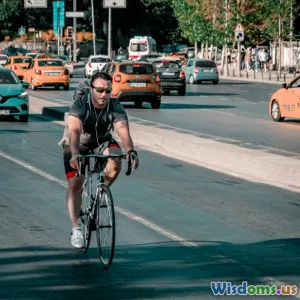
How Walkability Improves Health in Dense City Neighborhoods
9 min read Discover how walkable city neighborhoods boost physical, mental, and social health by encouraging active lifestyles and community engagement. (0 Reviews)
How Walkability Improves Health in Dense City Neighborhoods
Introduction
Imagine a city where every corner invites a stroll and every street echoes with footsteps instead of honking cars. Dense urban neighborhoods, often stereotyped as concrete jungles rife with health challenges, are quietly transforming into hubs of wellness through walkability. But what does "walkability" truly mean, and how does it clash with or blend into the buzz of dense city life? More importantly, how does it affect our health?
Walkability refers to the measure of how friendly an area is to walking. Factors that determine this include the presence and quality of footpaths, pedestrian rights-of-way, traffic and road conditions, safety, and connectivity to amenities such as shops, schools, parks, and workplaces. In dense neighborhoods, walkability is not just a lifestyle perk but a crucial mechanism that can drastically improve residents' physical, mental, and social health.
This article explores the multifaceted benefits of walkable urban environments, supported by data, case studies, and expert perspectives. It aims to inspire city planners, policymakers, and citizens to champion pedestrian-friendly designs for healthier lives.
The Link Between Walkability and Physical Health
Encouraging Regular Physical Activity
Physical inactivity is a global health concern. The World Health Organization reports that insufficient physical activity is a leading risk factor for mortality worldwide, contributing to conditions like heart disease, diabetes, and obesity.
Dense city neighborhoods that are walkable unlock natural opportunities for residents to incorporate exercise into daily routines effortlessly. Instead of driving short distances, inhabitants can choose to walk to local shops, transit stops, or neighbors’ homes.
For example, a 2015 study published in the International Journal of Environmental Research and Public Health analyzed the Atlanta metropolitan area. It found that residents in more walkable neighborhoods were significantly more likely to meet recommended physical activity guidelines, translating to better cardiovascular health.
Reducing Chronic Disease Risk
Increased walking lowers the risk of chronic diseases. The American Journal of Preventive Medicine highlighted in 2013 that neighborhoods designed with pedestrian safety, sidewalks, and easy accessibility to amenities showed consistently lower obesity rates—an influential factor in combating diabetes and hypertension.
Denver, Colorado’s urban renewal initiatives in the suburb of Globeville, integrated wide sidewalks, pedestrian crossings, and street cafes, fueling a rise in daily walkers. Subsequently, the community observed measurable decreases in obesity prevalence over a decade, demonstrating real-world benefits of walkability.
Positive Effects on Mental Health
Combatting Stress and Depression
City living is sometimes viewed as stressful due to noise, fast pace, and overcrowding. Yet, walkable neighborhoods can counterbalance these stressors. Walking itself releases endorphins, known as "feel-good" chemicals, reducing anxiety and elevating mood.
Moreover, walkable areas tend to incorporate green spaces like parks and tree-lined streets that psychologically soothe residents. Research from Stanford University showed that participants walking in natural environments reported decreased rumination—a pathological focus on negative thoughts—compared to walking in urban settings without greenery.
Enhancing Cognitive Function and Creativity
Regular moderate physical activity, such as walking, fosters improved cognitive function. An often-cited study from the University of Kansas reported that walking boosts creativity by an average of 60% compared to sitting. This cognitive benefit is essential for productivity, problem-solving, and overall mental sharpness, especially valuable in busy city environments where cognitive overload is common.
Social Health: Strengthening Community Bonds
Walkability Fosters Interactions
Dense neighborhoods without walkability often trap residents in isolation within their apartments or cars. Walkable environments become social catalysts, encouraging casual encounters, fostering trust, and building community ties.
Jane Jacobs, an urbanist and author, famously celebrated sidewalks as "spines" of community life. A 2017 survey in Portland, Oregon, supported this by showing that neighborhoods with greater walkability had increased social cohesion, where neighbors knew and helped one another more frequently.
Safety Through Eyes on the Street
Walkability also brings a public safety bonus. More pedestrians on streets mean more “eyes on the street,” deterring crime and improving real and perceived safety. This environment creates a positive feedback loop: safer streets inspire even more walking and community engagement.
Environmental and Health Synergies
Reducing Pollution Exposure
Dense neighborhoods traditionally wrestle with air pollution from vehicular traffic. Walkability reduces reliance on motorized transport, cutting emissions that aggravate respiratory illnesses.
Los Angeles, historically known for poor air quality, launched the "Green Streets" initiative, promoting walkable corridors. The project resulted in a drop in local asthma attack rates, especially among children.
Mitigating the Urban Heat Island Effect
Walkable neighborhoods often feature green spaces and shading, which help counter the urban heat island effect—a phenomenon where cities become heat traps due to concrete and asphalt. Cooler environments contribute to better cardiovascular health and reduce heat-related illnesses.
Challenges and Solutions in Fostering Walkability
Barriers to Walkability in Dense Neighborhoods
Despite benefits, dense urban environments face challenges such as uneven sidewalks, heavy traffic, poor lighting, and crime concerns that deter walking.
Older cities like New York City have tackled these issues by installing pedestrian plazas, extending curbs (bump-outs), improving lighting, and increasing police presence to create well-lit, safe, and comfortable pedestrian zones.
Policy and Community Initiatives
Real-change requires policy enforcement and community involvement. Cities like Copenhagen offer inspiring examples. Their comprehensive bicycle and pedestrian infrastructure investments have led to a resident population that cycles or walks more than 62% of the time for commuting.
A crucial lesson is integrating walkability into zoning laws, urban planning, and public health strategies, backed by funding and community feedback to make neighborhoods accessible, safe, and attractive to pedestrians.
Conclusion
Walkability in dense city neighborhoods transcends mere convenience; it serves as a powerful tool for improving health across physical, mental, and social domains. The evidence is compelling: walking-friendly environments increase regular physical activity, mitigate chronic diseases, reduce stress, foster social connections, and improve environmental conditions.
For cities aiming to be healthier and more livable, investing in walkability should be a top priority. It empowers individuals to lead active, engaged lives intertwined with their communities. As we design the future cities of tomorrow, let's remember that the simplest act—taking a walk—can unlock profound health benefits.
Walkable neighborhoods are more than thoroughfares; they are vital arteries of urban wellness.
References
- World Health Organization. Physical activity factsheet.
- Frank, L.D. et al. (2015). Walkability and physical activity in Atlanta. International Journal of Environmental Research and Public Health.
- American Journal of Preventive Medicine (2013). Obesity and walkability correlation study.
- Stanford University. Effects of nature walks on rumination.
- University of Kansas. Walking and creativity study.
- Jacobs, Jane. The Death and Life of Great American Cities.
- Portland Civic Survey (2017). Social cohesion data.
- Los Angeles Green Streets initiative report.
- City of Copenhagen transportation statistics.
This comprehensive exploration confirms that creating walkable dense neighborhoods is a vital strategy for urban health and wellbeing.
Rate the Post
User Reviews
Popular Posts




















